 | Psion History |
|
Dr David Potter read Natural Sciences at Cambridge University in 1963, followed by a doctorate in Mathematical Physics at Imperial College London. After several years as a university lecturer he decided to start his own software company and took various jobs to raise money. In 1980 he founded Psion in Baker Street, London, the name coming from "Potter's Scientific Instruments" with "on" tacked on to make it sound scientific. Psion first came to public attention in 1982 after writing some games programs for the recently launched Sinclair ZX81 home computer. The Psion games proved popular and when Sinclair released their ZX Spectrum computer Psion were commissioned to write software for that too. In addition to games Psion also produced some early 'serious' programs for the Spectrum, including a spreadsheet, database and 3-D drawing program: 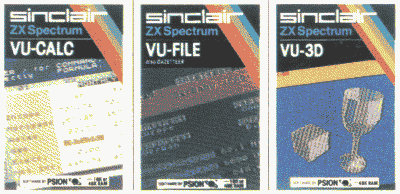 ZX Spectrum software written by Psion In 1983 Psion were also developing a suite of business software for the IBM PC, but when Sinclair approached them to produce something similar for the planned Sinclair QL home/business computer, Psion adapted their programs to the QL platform. Whilst the QL itself was not a commercial success the suite of Psion applications, comprising a word processor, database, spreadsheet and business graphics package, received good reviews for its features and quality of documentation. The suite did in fact appear on the IBM platform in 1985 as 'Xchange'. Psion realised there was a gap in the market for a fully portable computer which would keep its memory contents even when it was switched off, and thus Psion entered the computer hardware market in 1984 with the Organiser. The original organiser contained a clock, diary, calculator and simple database, but was limited in its usefulness by a small memory capacity of only 8 kilobytes and a single line display. The Organiser II of 1986 increased the display size and memory capacity which made more advanced applications feasible, including a spreadsheet and word processor. The Organiser was very tough and reliable and was popular in business as a portable data logger. The biggest faults of the Organiser range were its keyboard, which was small and arranged alphabetically, and its display of only 64 characters in total. Both these were rectified by Psion's MC range in 1989. The MCs were A4 sized laptop computers with a full keyboard and larger screen, at a price of £845. Thanks to low power microprocessors and absence of a hard disk battery life was much longer than for modern laptop computers so that the MC was truly free from the need for mains power. A new operating system, named EPOC, had been written for the MC and this was fully multitasking, with a simple graphical interface, and very stable, all before Windows® 3.1 appeared. The MC contained a diary, calculator, database and text editor, had 256 kilobytes of internal memory and had four expansion slots for cartridges containing extra memory or applications. However despite the technical innovation the MC seemed too expensive for what it could be used for (the original Organiser had cost only £100) and the MC did not sell in large numbers. In September 1991 Psion returned to genuinely pocket sized computers with the launch of the Series 3. This was of the folding 'clamshell' design and when closed was little larger than a pocket calculator. The Series 3 had a Qwerty keyboard, albeit with rather small and clicky keys, plus extra keys along the hinge for launching the built-in applications. These applications included a fully-featured word processor, a database and an advanced diary/alarm clock/calendar. Hardware wise the '3' had a largish liquid crystal display, 128 or 256 kilobytes of memory with expansion slots for adding more, and twenty to thirty hours battery life from two AA cells. The cheapest model sold for £199. The Series 3 used an NEC V30 microprocessor which was a low power consumption clone of the Intel 8086 processor used in desktop machines, and the EPOC operating system was extremely stable and much easier to use than the DOS or early versions of Windows® on IBM compatibles. A programming language called OPL (Organiser Programming Language) was included in the operating system and this allowed full use to be made of pull-down menus and dialog boxes, so that users could relatively easily write polished applications for their Series 3. A large amount of shareware soon became available. In 1993 the Series 3 was completely updated to the Series 3a. This had four times the screen area, a minimum of 512 kilobytes of internal RAM, a doubling of the clock speed of the processor, addition of a spreadsheet to the built-in applications, and digital sound, for a price of £329 for the 512K version. The Series 3a and its derivatives the 3c and 3mx (adding extra memory, a faster processor, improved applications etc. but retaining the 3a shape) is often considered to be the best such personal organiser ever made, and around 1.5 million were sold. Many Series 3 users stuck with their existing machines even when newer and probably better models appeared. 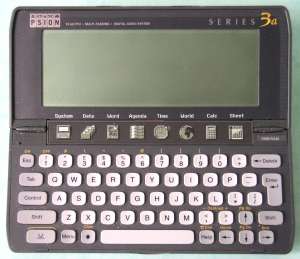 The Psion Series 3a
There was also a 'ruggedised' form of the Series 3, called the Workabout. The Workabout had a smaller screen, 240x100 pixels, used a non folding design which made it stronger, and it was waterproof. The keys were arranged alphabetically but essentially the Workabout was compatible with the 3a and was advertised as being suitable for " 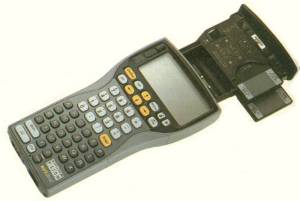 A Psion Workabout with the memory card/battery tray open Psion's next pocket computer in 1997 was intended to build on the success of the Series 3 whilst correcting its commonest criticisms. The Series 5 (there was never a Series 4, apparently because the number 4 is considered unlucky in some cultures) was approximately the same physical size as the Series 3 and again used the folding clamshell design, but with a much enhanced specification. The most noticeable feature was a keyboard that slid forwards as the case was opened, providing a large typing area with almost full size keys which permitted touch-typing. The Series 5 had a relatively large screen, the same number of pixels across as many desktop PCs of the time, and the screen was touch-sensitive so that the supplied stylus could be used like a mouse to make menu selections, highlight sections of text, etc. The price was a little high at £500 with 8MB of RAM, but this was still cheaper than any laptop PC. The in-built applications had been improved and the combination of WISYWYG display and a useable keyboard meant the Series 5 made a practical portable word processor. In 1999 the Series 5 was updated to the 5mx with a two times faster processor, more internal RAM and a clearer screen, with the price reduced to £400: 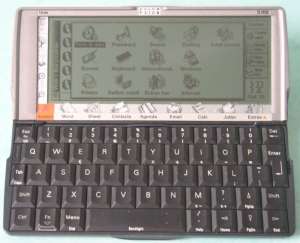 The Psion Series 5mx
The Psion Series 5 was in most respects an excellent pocket organiser that could also do most of what a much larger and more expensive laptop computer was used for. Competitors were beginning to appear in the PDA (Personal Digital Assistant) market, mostly the Palm OS machines and later Windows CE devices, but in comparative reviews in the computer press the Psion 5 tended to come out on top, mainly because it had a keyboard, a stable operating system and high quality applications. However not everything was perfect. Early models had some serious bugs in the supplied applications and Psion were slow to put these right. The Series 5 also seemed somewhat flimsy compared to the Series 3; the screen could easily get broken, the hinges for the complicated rotating/sliding case were not very robust, and there was the notorious problem of the flexible ribbon cable connecting the screen to the keyboard breaking, necessitating a very expensive repair.
In 1998 Psion's operating system and software division had been merged with Nokia and Ericsson to form a new company, Symbian, with the purpose of developing software for the next generation of mobile phones. The result was that Psion's former software engineers no longer worked directly for Psion and the close link between hardware and software design was broken. Perhaps this distracted Psion from their existing organiser business. In any event, by 2001 the four year old Series 5 was losing out to competition from newer Palm OS and Windows handheld devices and sales were falling. Also customer support for Psion's handhelds seemed to be dwindling. Many people expected Psion to announce a new model, probably with a colour screen and large memory but retaining the small size of the Series 3 and 5. Instead on 11th July 2001 Psion announced that it was ceasing development of handheld organisers. The existing models continued to be sold for a while but supplies gradually dried up. Psion joined with an American company named Teklogix who made industrial hardware and software, and became known as Psion Teklogix. There was no room for the EPOC operating system in this organisation (which exclusively used Windows) and in 2004 Psion sold its shares in Symbian to the other two partners. Thus Psion still exists, and is still listed on the stock exchange, but no longer makes computers for the general public. A combination of the size and marketing power of its American competitors, some poor design features of later models, failure to introduce improved models and a slightly cavalier attitude to previous customers were the downfall of Psion's PDA business. Former Psion staff can today be found working for TomTom on Sat-Nav systems, and for Apple on its i-Pod. The EPOC 32 operating system is in use in around 125 million mobile phones, mainly because of its amazing stability compared to some other OSs. | ||||||||||||||||||||||
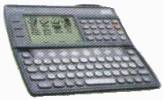 Psion's subsequent model, the Sienna (right) was a cut down version of the Series 3 with a smaller screen, less memory and a lower price, but was not particularly popular. It was worth paying the extra for the fuller featured contemporary 3c.
Psion's subsequent model, the Sienna (right) was a cut down version of the Series 3 with a smaller screen, less memory and a lower price, but was not particularly popular. It was worth paying the extra for the fuller featured contemporary 3c.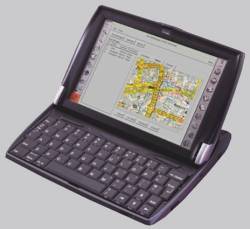 Psion's next model, also in 1999, received relatively little publicity, as if Psion did not really want to launch it. It had been developed purely for corporate buyers under the name Netbook (left) but was eventually released to the public in a cut-down form as the Series 7. The 7 had 32 MB of memory and for the first time on a Psion a colour screen, plus the usual Psion applications. It was about twice the size of a Series 5 but still much smaller than a normal laptop, and had a full VGA sized display. The Series 7 though was rather priced out of its market at around £800.
Psion's next model, also in 1999, received relatively little publicity, as if Psion did not really want to launch it. It had been developed purely for corporate buyers under the name Netbook (left) but was eventually released to the public in a cut-down form as the Series 7. The 7 had 32 MB of memory and for the first time on a Psion a colour screen, plus the usual Psion applications. It was about twice the size of a Series 5 but still much smaller than a normal laptop, and had a full VGA sized display. The Series 7 though was rather priced out of its market at around £800.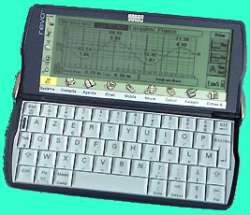 Just as the Sienna was a cheaper Series 3, Psion released a cheaper Series 5 at Christmas 1999. This was the Revo (right), looking quite similar to the Series 5 but smaller whilst retaining the 5's keyboard. The Revo however was limited compared to the Series 5. It had only 8 MB of RAM which could not be increased, and the screen was smaller at 480 x 160 pixels. This meant software for the Series 5 had to be altered to fit on the Revo, and many writers did not bother. Probably the worst feature of the Revo though was that it used an internal NiMH rechargeable battery with a life of only about twelve hours, after which the Revo had to be recharged from the mains using the bulky charger cradle - there was no option of just replacing the batteries. This made it almost essential to carry the charger around with the Revo, especially as all memory contents were lost if the internal battery were allowed to go completely flat. The design limitations of the Revo and reliability problems of the Series 5 dented Psion's reputation in the PDA market.
Just as the Sienna was a cheaper Series 3, Psion released a cheaper Series 5 at Christmas 1999. This was the Revo (right), looking quite similar to the Series 5 but smaller whilst retaining the 5's keyboard. The Revo however was limited compared to the Series 5. It had only 8 MB of RAM which could not be increased, and the screen was smaller at 480 x 160 pixels. This meant software for the Series 5 had to be altered to fit on the Revo, and many writers did not bother. Probably the worst feature of the Revo though was that it used an internal NiMH rechargeable battery with a life of only about twelve hours, after which the Revo had to be recharged from the mains using the bulky charger cradle - there was no option of just replacing the batteries. This made it almost essential to carry the charger around with the Revo, especially as all memory contents were lost if the internal battery were allowed to go completely flat. The design limitations of the Revo and reliability problems of the Series 5 dented Psion's reputation in the PDA market.